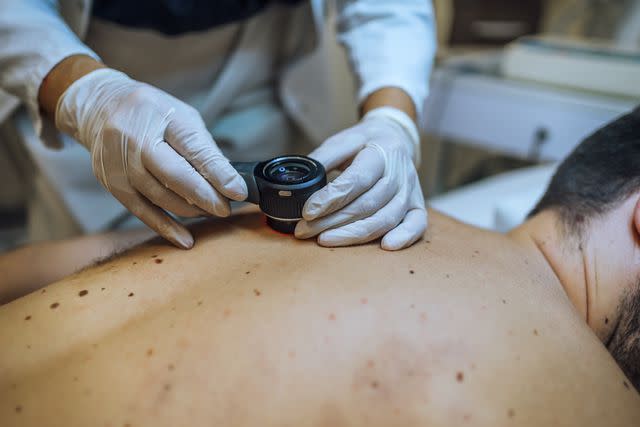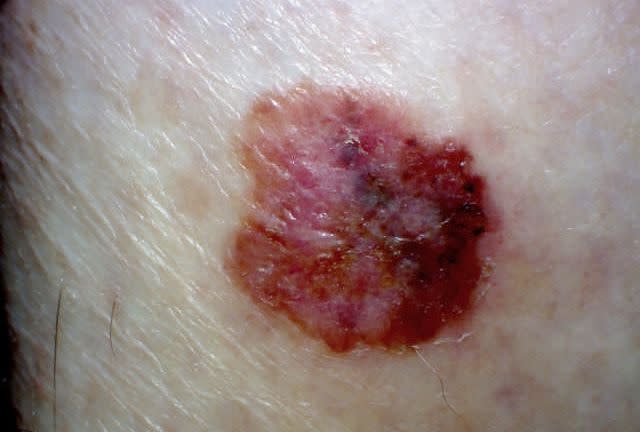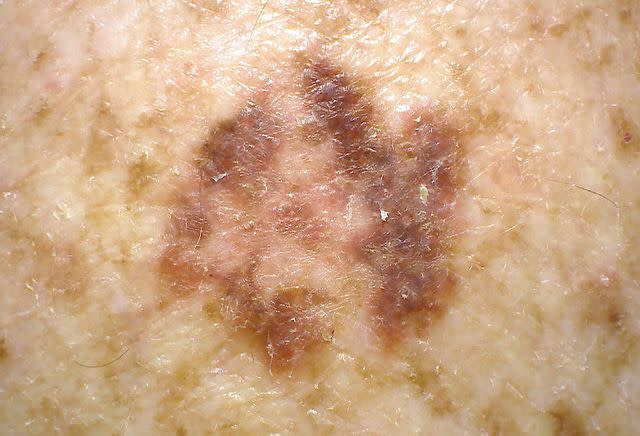Suspicious Skin Moles to Worry About
A Raised or Crusty Mole That Changes Color Would Qualify as Suspicious
Medically reviewed by William Truswell, MD
Finding a new mole or seeing changes in an existing mole can be worrisome. While many varieties of moles on the skin are harmless, others can indicate skin cancer. Moles that change in size and color, or erupt out of nowhere are the types that should be watched the closest.
This article discusses how you can identify moles that require medical attention and those that can be left alone.

LordHenriVoton / Getty Images
Characteristics of Concerning Skin Moles
There are many types of moles. Only some of them possess the characteristics that should prompt concern. Some attributes of concerning skin moles include:
A color change: Changes to the color of a mole can indicate changes to the cellular makeup. If a mole contains different shades of brown, black, or tan, with white, gray, red, pink, or blue areas, it could indicate a cancerous growth.
Moles that grow or shrink in size unevenly: Moles are typically round and evenly shaped. If the border of a mole begins to grow or shrink into an uneven shape, or the edges are ragged, notched, or blurred, it could be a sign of cancer.
Shape, texture, or height changes: Moles that grow in size could indicate cancer. The feel of the mole may also change and protrude out of the skin further and become scaly or dry. It may also feel hard to the touch or lumpy.
Changes in how it feels: Moles are typically painless and don’t cause discomfort. If a mole becomes itchy or painful, it may indicate the need for a dermatologist’s exam.
Blood or ooze: Moles are not supposed to release liquid, whether that be blood or something else. If a mole begins to bleed or ooze, it could indicate an issue.
Keeping Worry to a Minimum
The majority of moles are completely harmless. Even if you do notice changes, it does not necessarily mean that you have skin cancer. When you notice changes to any moles on your body, the best thing you can do is see a healthcare provider. They will test the mole for any cancerous changes, and the quicker you complete this step, the faster you can have it removed if it is cancerous.
Learn More: What Does Early Skin Cancer Look Like?
Skin Moles to Not Worry About
There are two types of moles that people can develop that rarely turn into cancer. They are common moles and dysplastic nevus moles.
These skin growths do not typically require a trip to a healthcare provider, as they are not likely to cause any issues.
Size | Color | Shape | Texture | |
Common Moles | Less than 5 millimeters (mm) | Pink, brown, black, or similar to a person's skin tone; even color throughout | Round or oval; symmetrical with clearly defined edges | Flat and smooth or raised and smooth |
Dysplastic Nevus | Larger than 5 mm | Mixture of brown, red, or pink | Irregular shape that can be notched or fade into the rest of the skin | Smooth with a slightly scaly feel; rough or pebbly appearance |
Melanoma | Wider than 6 mm | Uneven color in shades or black, brown, tan, white, gray, red, pink, or blue | Irregular and asymmetrical with ragged, notched, or blurred edges that fade into the rest of the skin | Mole that looks as though it's been scraped; hard and lumpy; can ooze blood or liquid |
Since dysplastic nevus moles have similar characteristics to melanoma moles, it may be more difficult to assume that one of these types of moles is nothing to worry about.
Melanoma vs. Dysplastic Nevus
While melanoma and dysplastic nevus have similar characteristics, they are different. For example, melanomas are typically wider than 6 mm, making them more prominent than the typical dysplastic nevus. Melanomas will also appear and feel differently, with the site looking as if it has been scraped or becoming hard or lumpy. They may also ooze or bleed, which does not happen to dysplastic nevus.
Related: Common Skin Growths
Skin Mole Risk Factors to Keep in Mind
Risk factors associated with moles could cause them to turn from harmless to malignant. Risk factors to be aware of include:
Exposure to ultraviolet light, whether from the sun or artificially
Having a lot of common or atypical moles
Fair skin, freckling, and light hair
Family history of melanoma
Personal history of melanoma or other types of skin cancer
Weakened immunity
Being over the age of 30
Being male
Having a rare and inherited condition known as xeroderma pigmentosum, which causes issues with the skin’s ability to repair damage
Knowing Your Risk Factors
Having risk factors does not mean that you will automatically develop skin cancer from moles. However, they do indicate that you may be more likely to develop a cancerous mole. When you know you have a heightened risk, you can take precautions to ensure that if a suspicious mole does develop, it doesn’t go unchecked.
Ruling Out Suspicious Moles: When to See a Dermatologist
Once you know what to look for when spotting a suspicious mole, it’s easier to keep track of any old and new growths you have on your body.
You should check your entire body once every month for changes to current moles or new ones, especially if you fall into a higher-risk category. That way, you’ll be able to see a dermatologist as soon as you notice any changes.

Reproduced with permission from © DermNet and © Waikato District Health Boardwww.dermnetnz.org 2023.
Melanoma with color variationWhile not all moles will be cancerous, seeing a dermatologist can help prevent cancerous cells from spreading to other body areas. To determine if a mole needs to be checked, remember the ABCDEs of early detection:
A (asymmetrical): One side of the mole is different from the other.
B (border): The edges of the mole are uneven, blurry, or jagged.
C (color): There is more than one color or shade in the mole.
D (diameter): The mole is or grows to be larger than 6 mm in diameter.
E (evolution): The mole changes in size, shape, or color over time.
Related: When Should You Get Rid of a Mole?

Reproduced with permission from © DermNet and © Waikato District Health Boardwww.dermnetnz.org 2023.
Summary
Discerning between suspicious moles and those that cause no threat to your health can be difficult if you don't know what you're looking for. That said, getting to know the moles on your body is vital so you can keep track of any changes. That way, you'll be well-equipped to stop serious cancers from spreading throughout the body if you develop a cancerous mole.
By remembering the ABCDEs of early detection and checking yourself regularly for changes, you can take control of your health in a way that could prevent the development of skin cancer or help you catch it early so that it doesn't become life-threatening.
Read the original article on Verywell Health.

